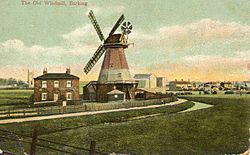Wellington Mill, Barking facts for kids
Quick facts for kids Barking Windmill |
|
|---|---|

The mill c1907
|
|
| Origin | |
| Mill name | Wellington Mill |
| Grid reference | TQ 436 839 |
| Coordinates | 51°32′10″N 0°04′11″E / 51.536182°N 0.069787°E |
| Year built | 1815 |
| Information | |
| Purpose | Corn mill |
| Type | Smock mill |
| Storeys | Four storey smock |
| Base storeys | Two storey base |
| Smock sides | Eight sides |
| No. of sails | Four sails |
| Type of sails | Patent sails |
| Winding | Fantail |
| Fantail blades | Six blades |
| Year lost | 1926 |
Wellington Windmill was a special type of windmill called a smock windmill. It stood tall in Barking, which is now part of the London, but used to be in Essex. This important mill helped grind grain for over 100 years, from 1815 until it was taken down in 1926.
Contents
What Was the Wellington Windmill?
The Wellington Windmill was a large building with a unique shape, like a person wearing a smock (a loose outer garment). It had four sails that caught the wind to power its machinery. Its main job was to be a corn mill, which means it ground grain into flour. This flour was then used to make bread and other foods.
Built for a Purpose
The windmill was built in 1815. It was designed to help with the work at another nearby mill located at Marks Gate. The mill was given its name, Wellington Windmill, to celebrate a very important event: the victory of the Duke of Wellington at the Battle of Waterloo. This battle happened in the same year the mill was built.
How a Smock Mill Works
A smock mill is a type of windmill that has a wooden tower, often shaped like an eight-sided pyramid. This tower is usually covered with weatherboards to protect it from the elements. At the top of the tower, there's a cap that can turn to face the wind. This cap holds the large sails. The sails spin when the wind blows, turning a long shaft inside the mill. This shaft then powers the heavy millstones that grind the grain.
People Who Ran the Mill
Over the years, different people operated the Wellington Windmill. In the later part of the 1800s, a person named Francis Whitbourne was in charge. Later, the Firman family took over running the mill. They made an important upgrade in 1906 by adding electric power. This meant the mill could still grind grain even when there wasn't enough wind.
The End of an Era
After more than a century of service, the Wellington Windmill was eventually taken down in 1926. Many old windmills were removed as new technologies and ways of grinding grain became more common. Even though it's gone, the Wellington Windmill remains a part of Barking's history.

